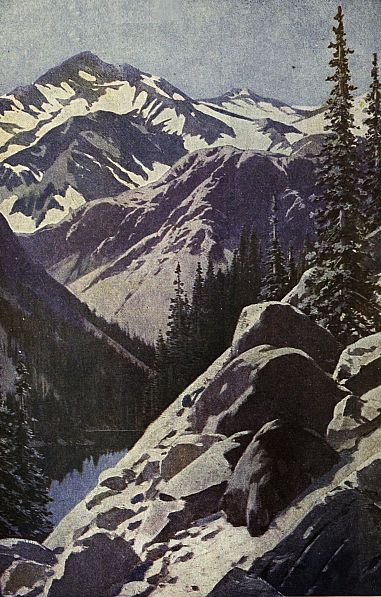By Stewart Edward White (1907). What a gem this Project Gutenberg ebook is. Though you may be ‘ultralight’ in your hiking/hunting methodology now there is much you owe to strategies outlined here so long ago, or which you may have forgotten, and should re-learn. Anyway it will make an excellent Xmas holiday read if you download it to your phone for free. The contents and list of illustrations may give some hint of the joys within.

| CHAPTER | PAGE | |
| I | The Wilderness Traveler | 3 |
| II | Common Sense in the Wilderness | 23 |
| III | Personal Equipment | 35 |
| IV | Personal Equipment (Continued) | 63 |
| V | Camp Outfit | 79 |
| VI | The Cook Outfit | 97 |
| VII | Grub | 115 |
| VIII | Camp Cookery | 135 |
| IX | Horse Outfits | 149 |
| X | Horse Packs | 169 |
| XI | Horses, Mules, Burros | 203 |
| XII | Canoes | 221 |
ILLUSTRATIONS
| The home of the Red Gods | (Frontispiece) |
| OPPOSITE PAGE | |
| On the trail (from a painting by N. C. Wyeth) | 16 |
| The Author doing a little washing on his own account | 32 |
| “Mountain on mountain towering high, and a valley in between” | 48 |
| One of the mishaps to be expected | 64 |
| “Bed in the bush with stars to see” | 80 |
“We may live without friends, we may live without books, but civilized man cannot live without cooks” | 104 |
| When you quit the trail for a day’s rest | 120 |
| In the heat of the day’s struggle | 144 |
| Nearing a crest and in sight of game | 160 |
| A downward journey | 176 |
| In mid-day the shade of the pines is inviting | 208 |
| Getting ready for another day of it | 224 |
A sense of direction, therefore, I should name as the prime requisite for him who would become a true woodsman, depending on himself rather than on guides. The faculty is largely developed, of course, by much practice; but it must be inborn.
The sense of direction in its simplest and most elementary phase, of course, leads a man back to camp, or over a half-forgotten trail. The tenderfoot finds his way by little landmarks, and an attempt to remember details. A woodsman adds to this the general “lay” of the country, the direction its streams ought to flow, the course the hills[5] must take, the dip of strata, the growth of trees. So if the tenderfoot forgets whether he turns to right or left at a certain half-remembered burnt stub, he is lost. But if at the same point the woodsman’s memory fails him, he turns unhesitatingly to the left, because he knows by all the logic of nature’s signboards that the way must be to the left. A good mountaineer follows the half-obliterated trails as much by his knowledge of where a trail must go, as by the sparse indications that men have passed that way…’
Worth a read, don’t you think?
Download it here: http://www.gutenberg.org/files/32950/32950-h/32950-h.htm
